Meditation in Kyoto Review: What to Expect at a Zazen Class
Are you thinking about taking a class on zen meditation in Kyoto? Whether you’re an experienced meditator or beginner, I’ve found the perfect class just for you.
You may realise that in our busy modern world, the number of fast-paced, day-to-day distractions bestowed upon us can cause us to feel a sense of disconnect. And not just from our inner selves, but to our world around us. And as I’ve recently learnt, meditation is a way we can restore it!
Although skeptical in my younger years, my regular visits to temples in Japan over the past decade have caused me to become increasingly fascinated with spirituality. Especially in Kyoto, there are reminders and symbolism of it at every turn – it’s hard to not become curious.
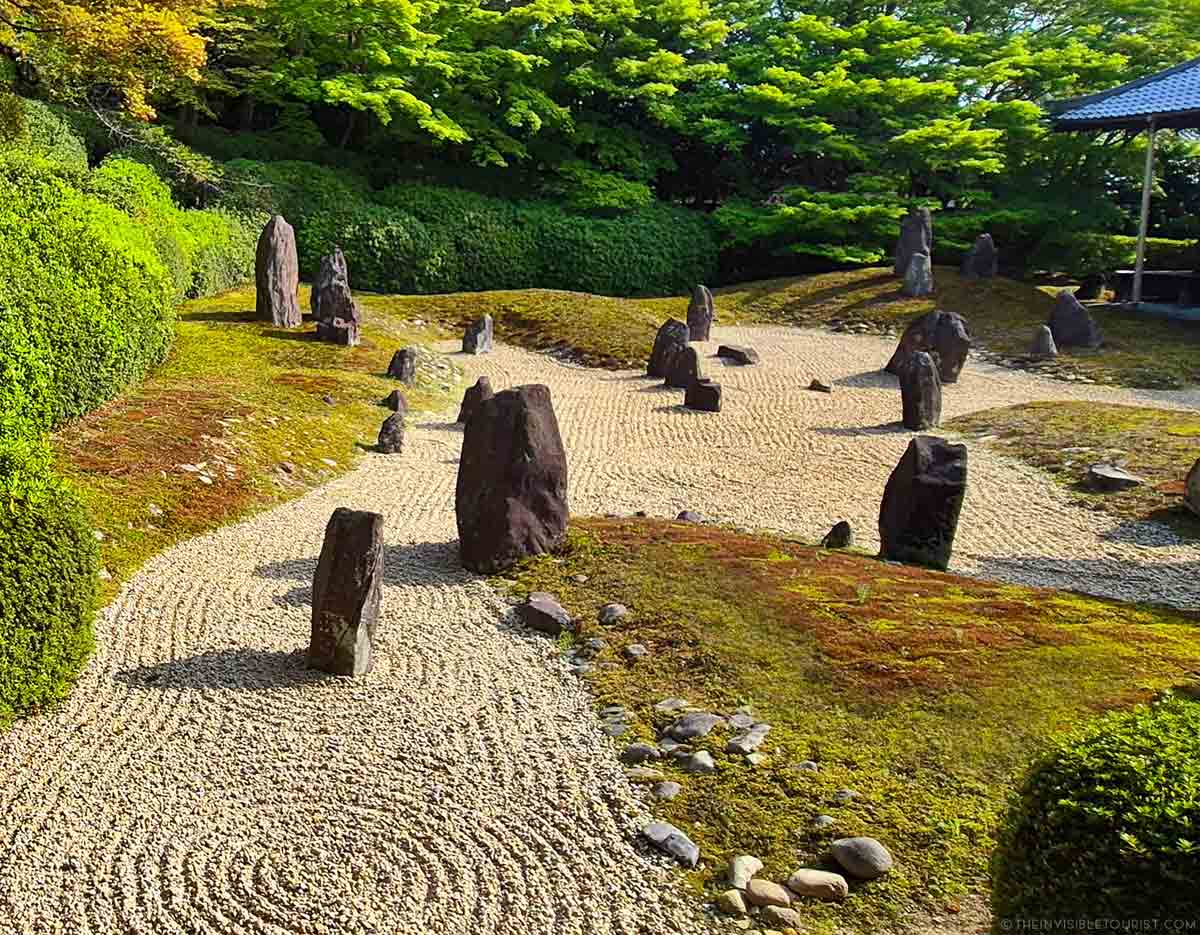
Delving deeper into the world of spirituality, I craved to learn more about zazen meditation, how it makes one feel and the afterglow of such an experience. What would I take away from this experience that I could apply to invite a little “zen” into my everyday life?
Who better to learn from than an actual master of meditation and all things zen at one of Kyoto’s most special temples? What does it entail? The results were surprising!
If you’d like to know what to expect in a zazen class and learn how to truly “feel” the world around you in a way that you’ve never before and, read on for more!
I took part in this meditation in Kyoto class as a press invite. All thoughts and experiences are my own. This post contains affiliate links, at no extra cost to you. I may earn a small commission if you click through and make a purchase.
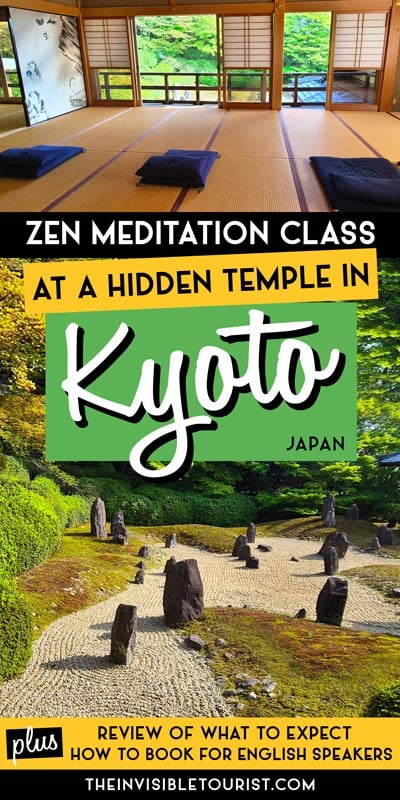
To bring you this zazen meditation in Kyoto experience, I’ve teamed up with local experts at Wabunka. Their dedicated team has curated dozens of meaningful cultural experiences such as this throughout Japan, so I recommend checking them out.
What is zazen meditation?
In its simplest terms, Zazen is a form of seated meditation where one sits cross-legged on the floor with their eyes open. It helps us realise and observe the present through our senses. I took this zazen meditation class and highly recomend it.
Zazen Meditation at Komyo-in Temple Kyoto
Perhaps you have heard of Tofuku-ji Temple 東福寺, to the south of popular Fushimi Inari Tasiha Shrine 伏見稲荷大社? Famed for its fiery autumn colours and various landscaped gardens, Tofuku-ji is head of the Rinzai sect of Buddhism and is the largest zen temple in Kyoto.
This experience was held at Komyo-in Temple 光明院, which is one of 25 subtemples that make up the Tofuku-ji Temple complex. Komyo-in was founded in 1391, and its thoughtfully designed karesansui 枯山水 (dry landscape garden) sits at its heart and soul. More about the garden in a moment!
Meeting my interpreter
I first met my interpreter Naomi-san at the meeting point. She was honestly so amazing and did a wonderful job translating the conversations with our host during the experience! Afterwards, she was able to answer many of my questions related to spirituality too. I could have spoken to her for hours!
We walked to the temple together, its small entryway is easy to miss. As we entered the temple grounds, Naomi-san explained the meaning of the rock formation that welcomed us and why it makes an important first impression.
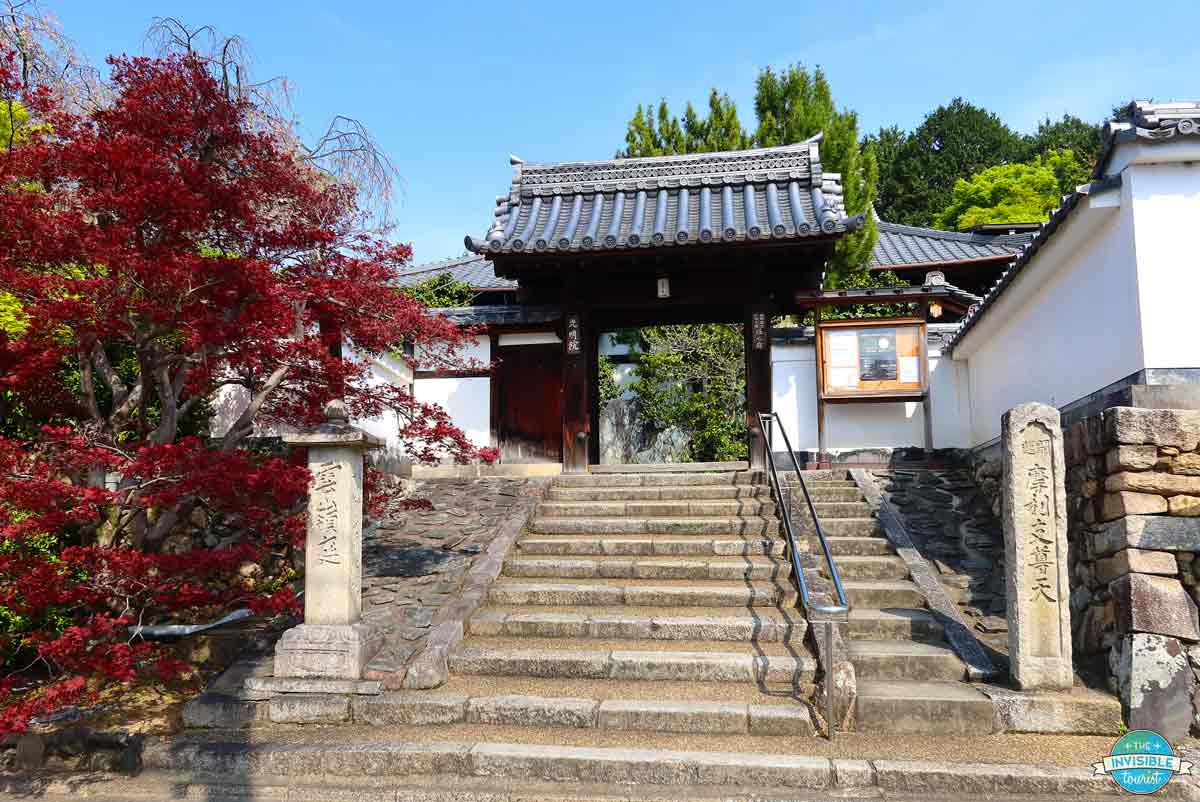
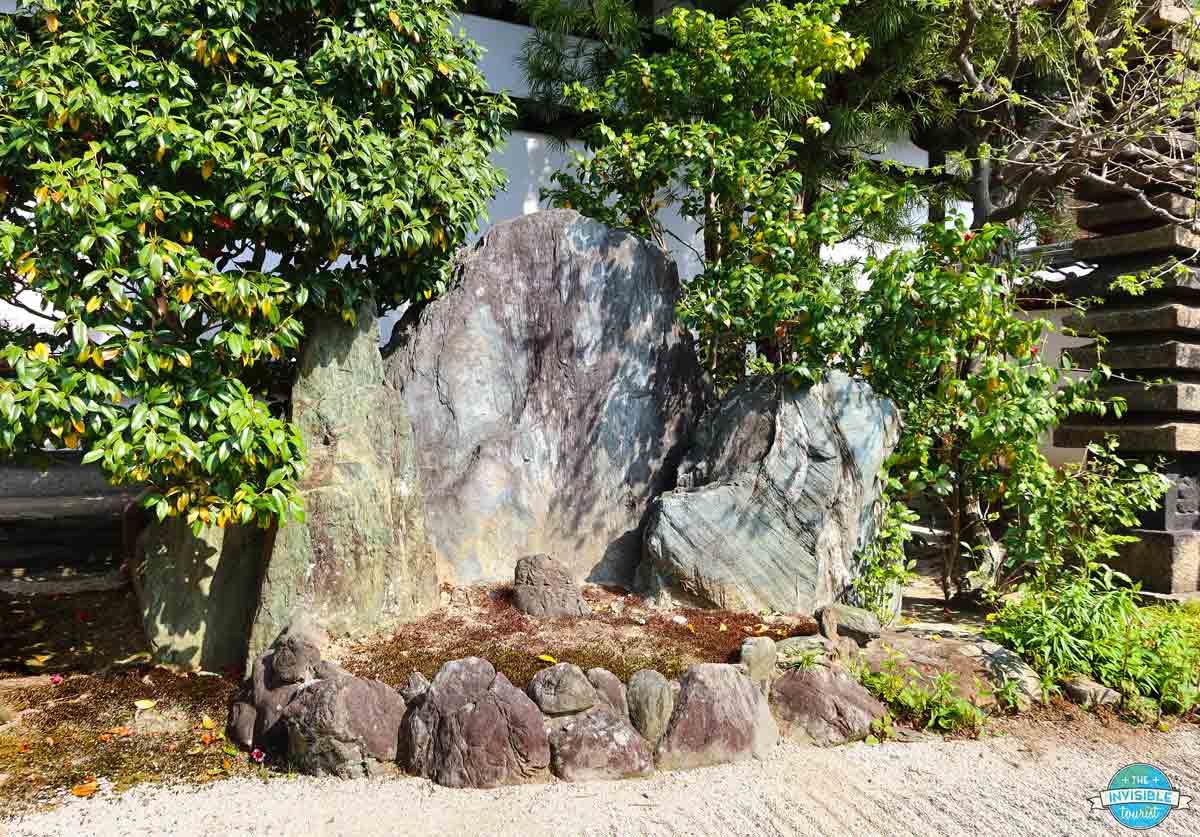
Meeting our Kyoto meditation master
Making our way inside the temple, we waited for our host. Zensō 禅僧, a lovely zen monk, welcomed us to the temple.
NOTE: Your Japanese meditation experience will be hosted by the temple’s chief priest. On the day of my experience he was unavailable, so I was hosted by a zensō as a rare exception.
We all made our way across the tatami flooring to the large wooden deck overlooking the garden to sit. I let out a gasp, such a lovely view! The jewel in the temple’s crown, the Rainbow Moss Garden, is a gorgeous sight – photos don’t really do it justice as its moss really is multi-coloured to the eyes.
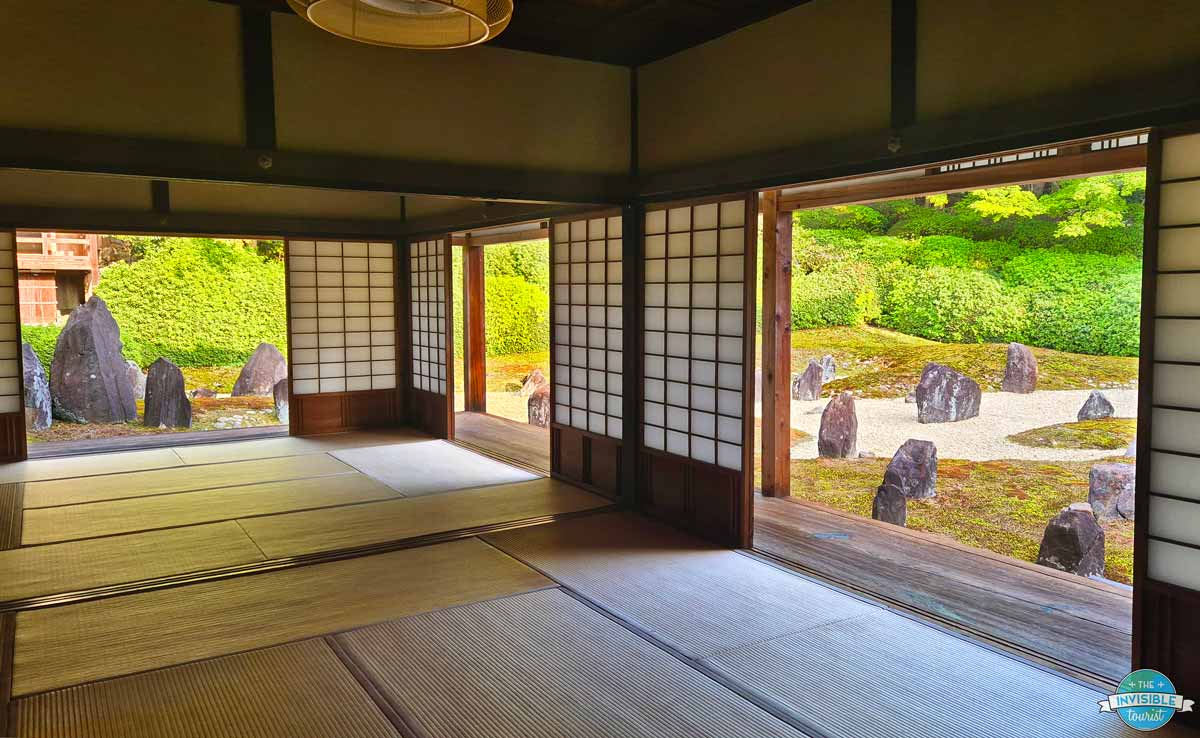
Learning about Komyo-in Temple
Our zensō explained the reasons why he decided to choose this pathway in life (turns out he had a profound experience in my native Australia that inspired him!). What a serendipitous connection.
Zensō described the garden’s layout and the designer’s vision. In my images below, notice the layers and how they complement each other.
The entire scene depicts a moon shining down through clouds over an ocean. Can you see it?
Here is the breakdown:
- Dry white gravel, representing water (and when it rains heavily, the gravel literally becomes water)
- Different shaped stones, with as much beneath the ground as above, representing the essence of us (visible vs invisible)
- Puffy azalea bushes, representing clouds. These burst into bright colour in late spring
- Japanese maple trees, adding depth and a red contrast during autumn
- The moon is said to cast an illuminating white glow over the rocks and stones. Everything around them is perpetually changing, but they remain constant.
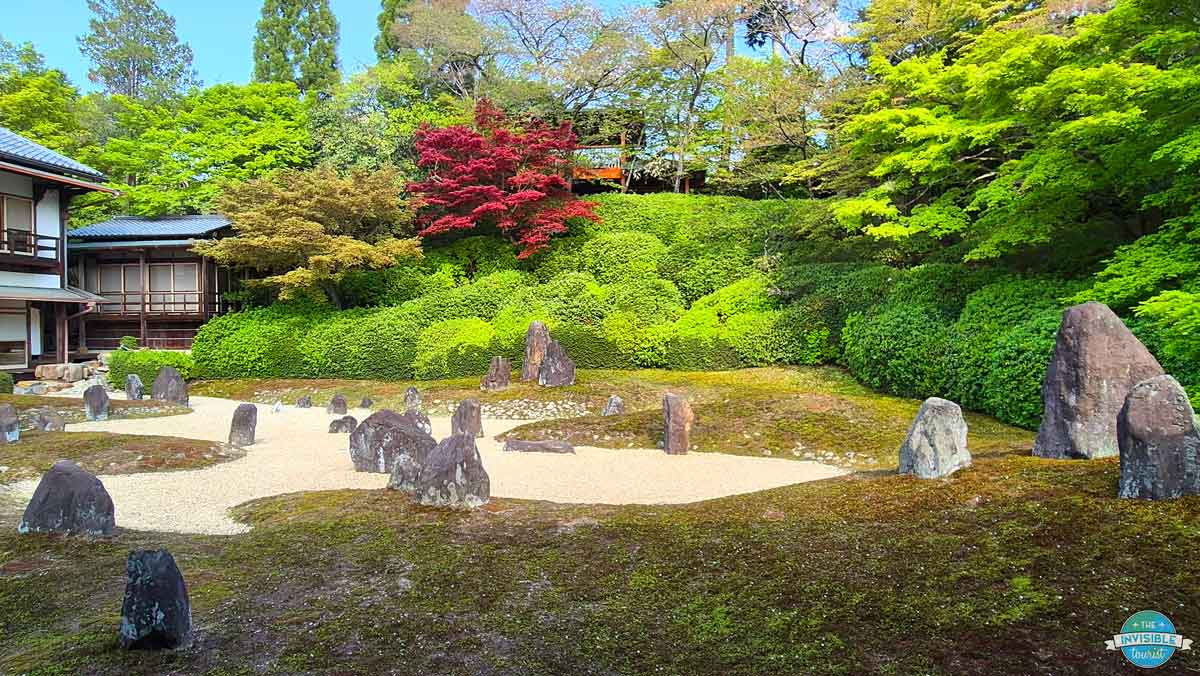
As the sun peeked in and out behind clouds, we were able to observe the garden in different light momentarily; the colours and shadows completely changed the feeling on this warm spring day. You can imagine the delicate Japanese maples creating the ultimate contrast of red against the emerald greens of azaleas in autumn, right?
Zensō then motioned us over to a special altar with a golden Bodhisattva, explaining why in Buddhism one should avoid becoming attached to material things. We admired the surrounding artworks on the sliding doors, especially the giant dragon painted above the doorframe.
Did you know there are different sects of Buddhism in Japan? Zensō explained the differences between them. When comparing Rinzai vs Soto Buddhism, if you are familiar with the story of Daruma-san you may be able to relate to why his arms and legs are believed to have fallen off!
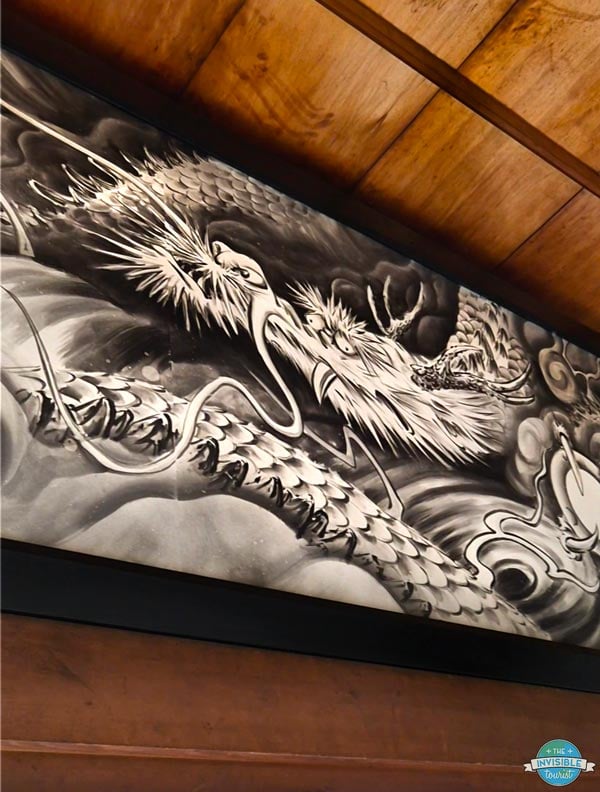
The zazen practice & lessons learnt
Now it was time to put zazen into practice. We made our way upstairs into an inviting room overlooking the garden below. This room is closed off to the public. What a perfect place to learn meditation in Kyoto!
Zensō instructed us to sit on the floor cushions, legs crossed and eyes open looking straight ahead, spine as straight as possible. He then rang a bell, and we meditated for what felt between five to ten minutes (I didn’t check the time).
In that time, sitting in complete silence, it became easier to focus on my senses. The whole idea is to focus on the now. Thoughts and realisations will come to you.
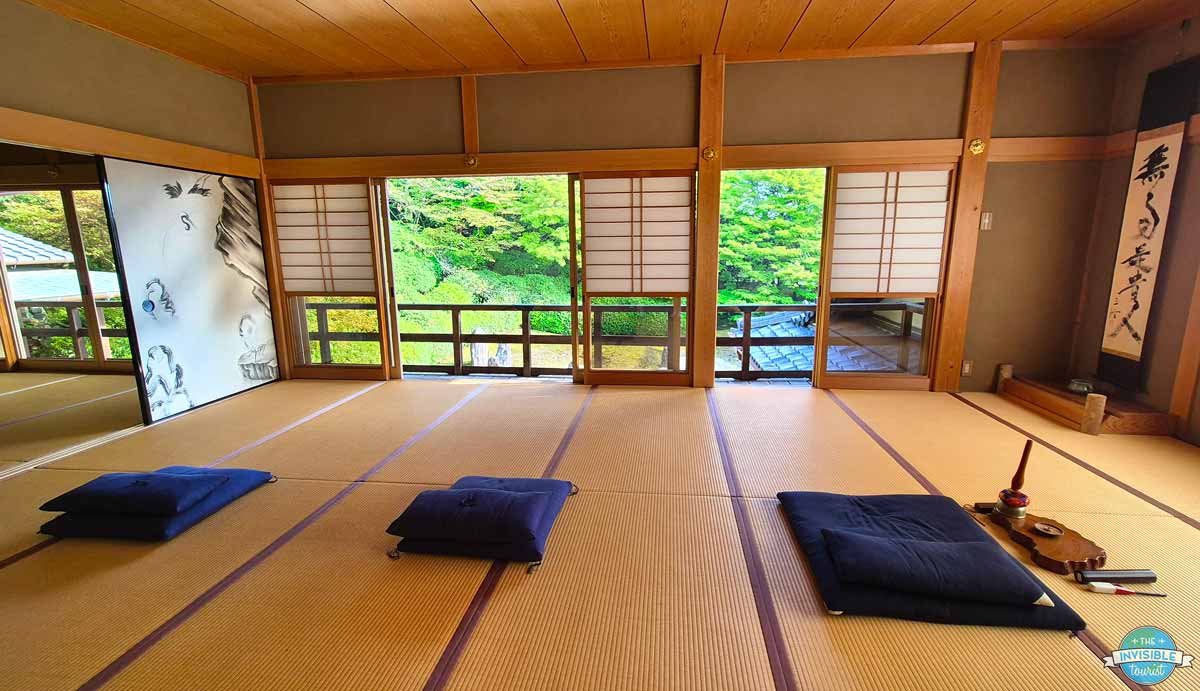
All my senses during the meditation felt amplified:
- Sound: Hearing beautiful birdsong in the nearby and breeze rustling tree leaves;
- Touch: Feeling a light breeze enter the room to brush against my face;
- Smell: Pleasant mixture of subtle scents – Timber from the room’s carpentry and tatami flooring, smoke from incense burning;
- Sight: Seeing the leaves gently bending in a flowing motion, at one with the breeze.
The bonus was zensō used a wooden stick against our backs to check our posture was correct. Thinking mine was ok (as best I could!) I was surprised when he pointed out areas where I wasn’t!
After the first seated session, we then tried another laying on our backs. This really helped to sharpen my attention to detail in another way.
This time looking at the ceiling, I noticed my senses heightened:
- Touch: Feeling the natural fibres of the tatami floor beneath my fingertips
- Smell: Could smell “spring” on the light breeze coming and going;
- Sight: Could see detailed and intricate patterns on the woodgrain carpentry and light fixture on the ceiling.
When I first walked into this room, I didn’t notice any of these things. But by really taking the time to just “be” and absorb what was around me, it gave me a whole new appreciation for the room and what lay outside it. Everything is connected.
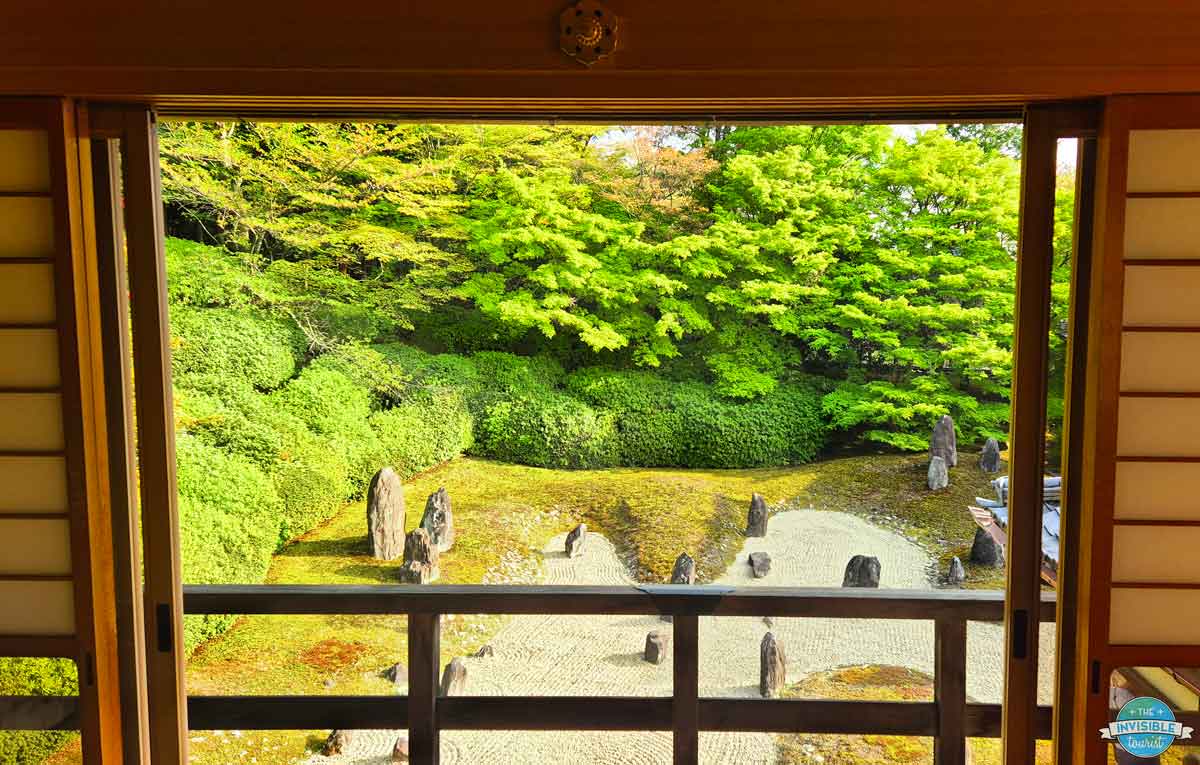
Enjoying matcha & wagashi afterwards in an artistic tea room
As a final treat, we moved into an adjoining tea room. Painstaking detail adorned the sliding doors. No photos were permitted here, but my goodness, what an impressive and creative piece of art — a deep sea creature creating an earthquake!
A young local artist blended the modern with the old through various art styles in the one piece. Their talent shines through in the piece as it incorporates elements from outside such as the rocks, bringing the outside flowing in. It’s very masterfully done, you’ll have to see for yourself.
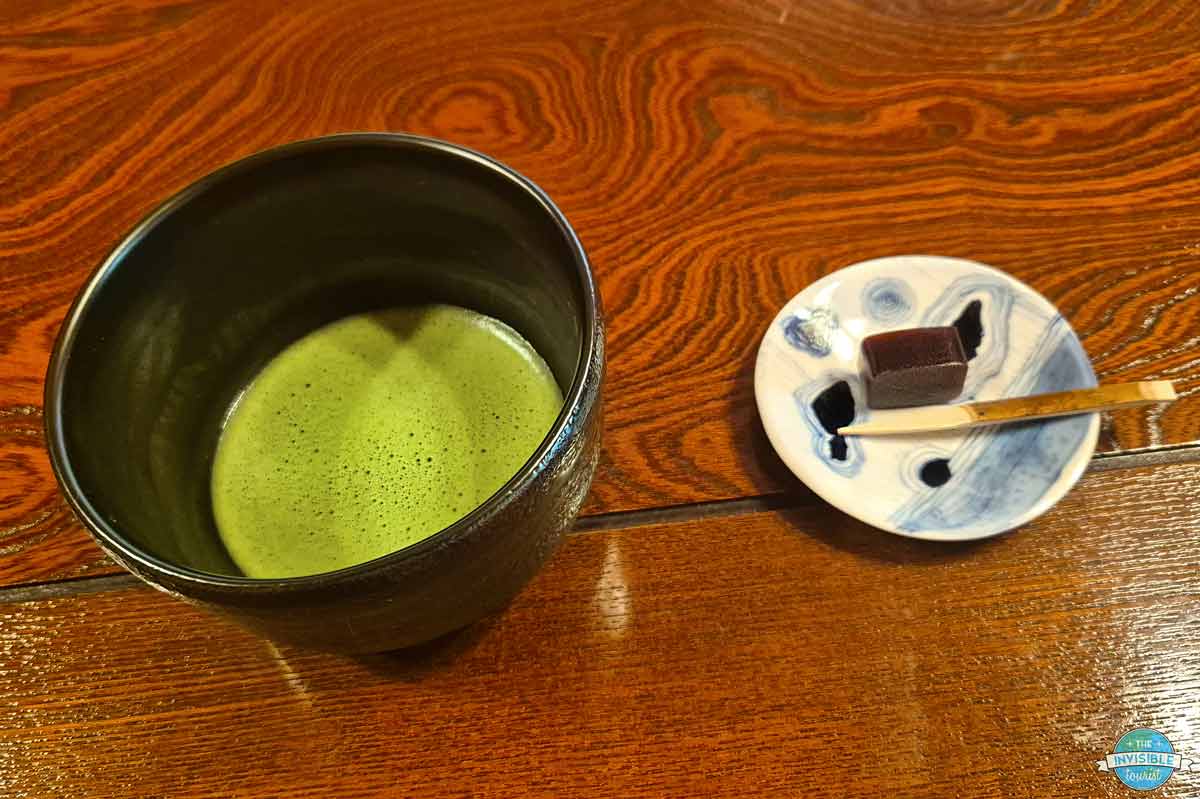
Benefits of taking a Kyoto meditation class
Of course, you could enjoy Komyo-in as a regular visitor on your own. However, for an even more meaningful experience, the benefits of taking a class on zen meditation in Kyoto like this include:
- Learning exactly how to practice zazen meditation from a chief priest
- Having the opportunity to ask the priest questions
- Having an interpreter to translate to English if you don’t speak Japanese
- Accessing beautiful rooms that are closed off to the public
- Enjoying matcha with the priest afterwards
- Take home your learnings and apply them in your daily life.
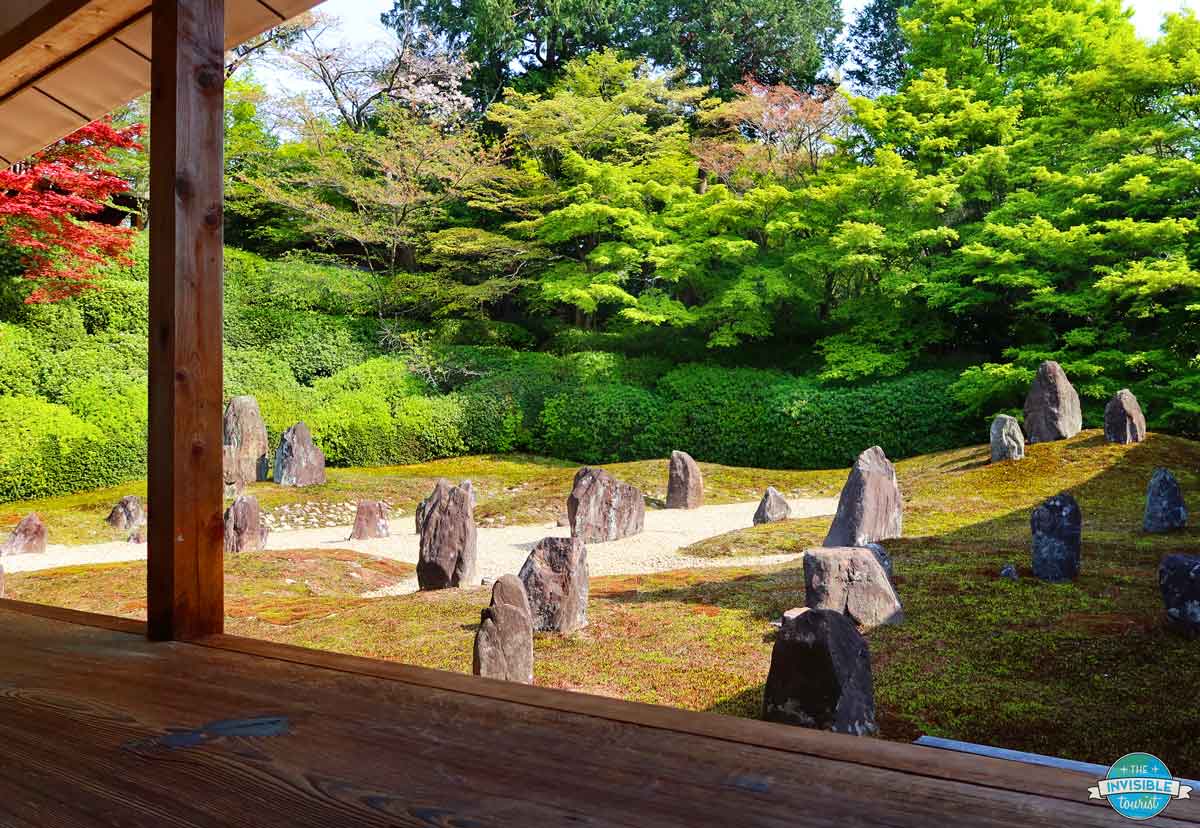
Final thoughts on my Kyoto zen meditation class
Participating in this class absolutely changed my perspective on the way I look at completing mundane tasks, and what it means to just sit and “be”. It is so easy to get distracted by our phones or want to look at them as an external source of entertainment to pass the time.
But meditation teaches us to use the tools we already have (senses and mind) to reach within ourselves to find more meaning and fulfillment in our lives. Answers to questions we have and revelations can reach us through the power of silence and observation.
These valuable teachings can help us feel more connected to ourselves and the world around us, just as nature intended.
I am in no way an expert on the subject, but I have noticed positive changes since I began incorporating some zazen practices into my life. I’ve come to the realisation that we are more than just our physical bodies. Isn’t that so special?
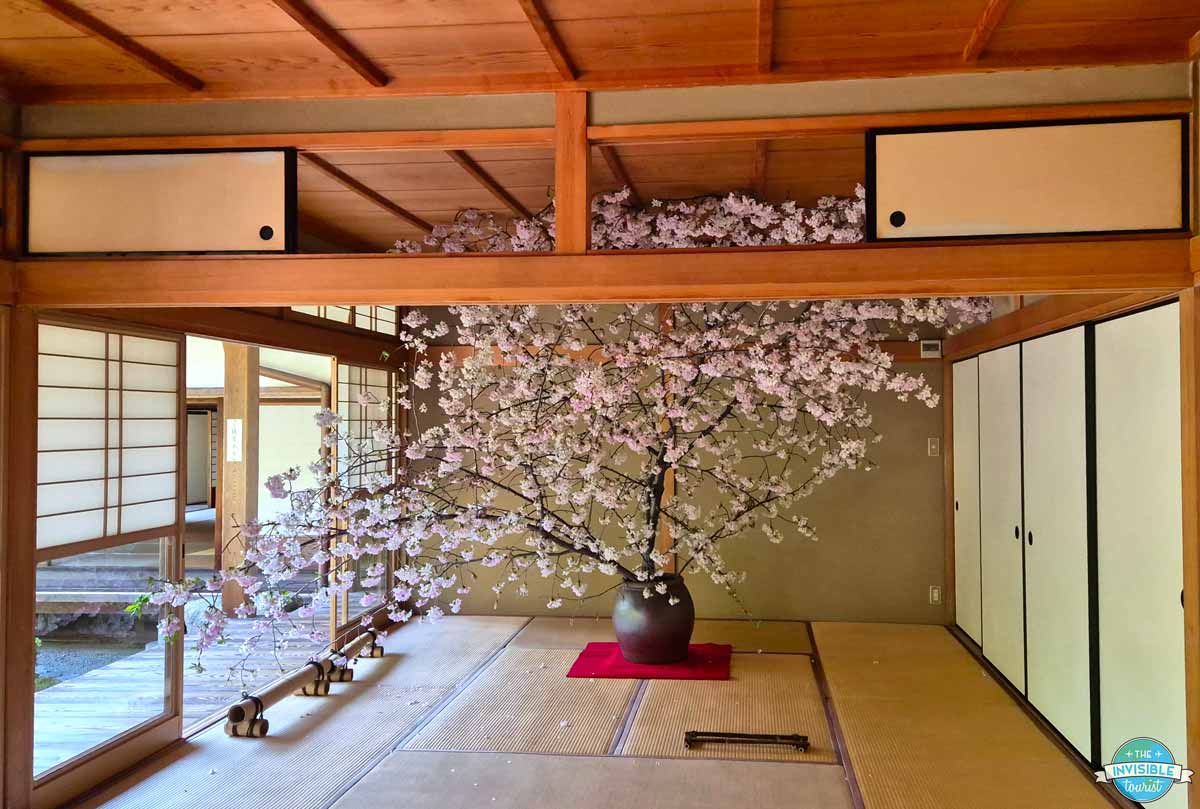
Sending a huge thanks again to Wabunka for inviting me to take part in this inspiring zazen experience, to our zensō and to Naomi-san who helped make the day one I will never forget!
Book other Kyoto experiences with Wabunka:
- Forge your own knife in a Kyoto workshop →
- Tie-dye at a cotton stole century’s kimono manufacturer →
- Visit a tea plantation & enjoy tea tasting in Kyoto →
- Enjoy a traditional kaiseki meal at a 250 year old restaurant →
- Learn kintsugi (repairing crockery with gold) at a villa →
- Experience Noh theatre with tea & sweets in a rural villa →
- See all Wabunka experiences throughout Japan →
For more cultural experiences like this, read my reviews of:
- Kyoto tea ceremony with a geisha
- Tokyo tea ceremony with a 5th generation tea master
- Learn Japanese culture from a geisha in Tokyo
- What to expect at a Kyoto cooking class
And for all my travel guides & itineraries, head to my extensive Japan travel blog:
If you found this helpful, please share it with someone you’re hoping to visit Japan with and join me on Facebook, my Japan Off the Beaten Path Facebook group, Pinterest, YouTube, Instagram and TikTok for more ways to “be invisible” on your travels!
Until next time,

Like it? Pin it! 📌
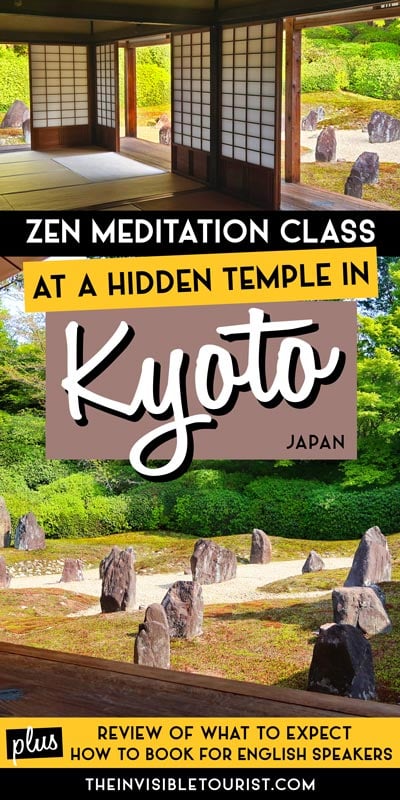
This guide to zazen meditation in Kyoto contains some affiliate links, at no extra cost to you. I may earn a small commission if you decide to make a purchase and if you do, thanks for your support! This helps with the costs of running my blog so I can keep my content free for you. As always, I only recommend a product or service that I genuinely love and use myself!
Like what you see? ✅ Sign up for my latest updates!

